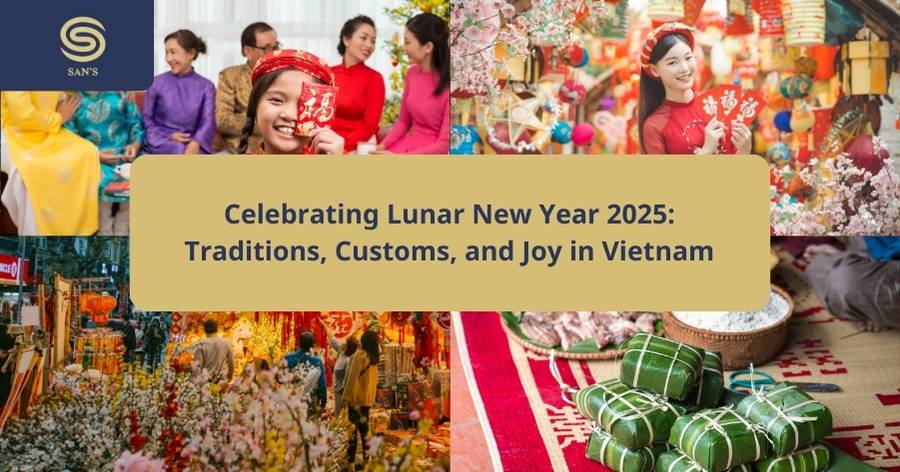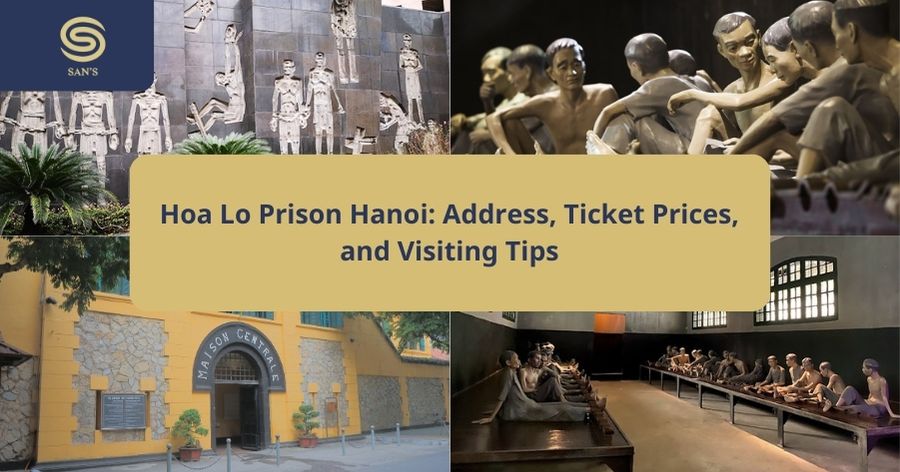Tet Nguyen Dan (Lunar New Year 2025) is Vietnam’s most anticipated and heartwarming celebration, marking the arrival of spring and a new beginning. As 2025 approaches, the country buzzes with vibrant traditions. Streets are aglow with red lanterns, markets are filled with colorful flowers, and families gather to share stories, laughter, and festive foods. Join Sanhotelseries as we explore what Lunar New Year 2025 is like in Vietnam!
What is the traditional Tet holiday in Vietnam?
In East Asian culture, deeply rooted in the wet rice civilization, the agricultural calendar divides the year into 24 solar terms. Each term marks a specific phase in the agricultural cycle and corresponds to a unique moment of transition. Among these, the most significant is the “Beginning of the Year”, signaling the start of a new cycle of planting and cultivation.
This pivotal solar term, known as “Tết Nguyên Đán”, later became what we now celebrate as Lunar New Year 2025. Deeply influenced by the traditions of ancient wet rice farming, Vietnam’s New Year embodies a timeless connection to its agricultural heritage, blending history, culture, and the promise of renewal.
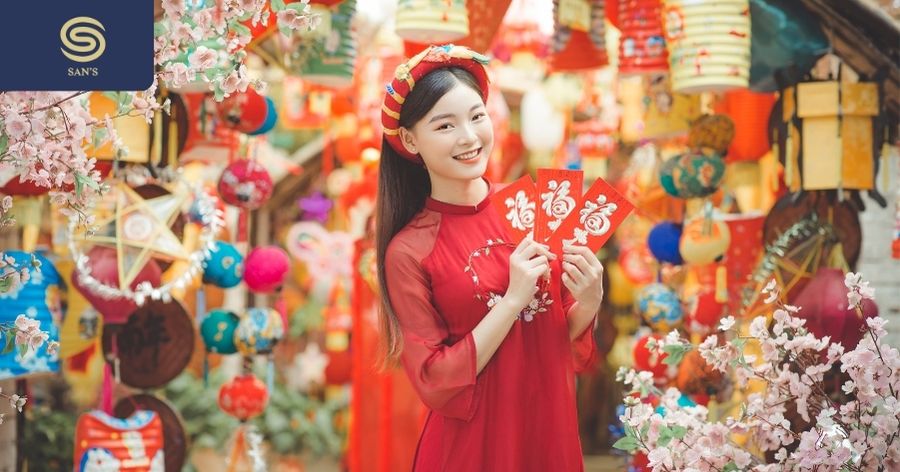
Main stages of Tet holiday in Vietnam
Vietnamese people believe that everything during Tết must be fresh and new, symbolizing a clean slate for the year ahead. That’s why preparations often begin more than two weeks before the Lunar New Year. Families thoroughly clean and decorate their homes, buy flowers, and stock up on food to ensure a festive and well-prepared celebration.
Unnecessary items or those believed to bring bad luck are discarded to clear the way for prosperity and happiness. Lunar New Year 2025 takes place from December 23, 2024 – January 10, 2025 lunar calendar (January 22, 2025 – February 7, 2025 solar calendar).
Ông Công ông Táo (on December 23, 2024 lunar calendar)
The official preparations for Lunar New Year in Vietnam typically begin on the 23rd day of the 12th lunar month, a day dedicated to honoring Táo Quân – the Kitchen Gods. In Vietnamese belief, Táo Quân not only governs the household kitchen but also records the good and bad deeds of each family member throughout the year. These records are then presented to the Jade Emperor during an annual heavenly report.
The ceremonial offering for Táo Quân is performed at midday or in the afternoon of this special day. The ritual includes incense, candles, fruits, paper offerings, and a set of three ceremonial hats-two for men and one for women-accompanied by three carp. The carp, whether real or made of paper, play a symbolic role as they are said to transport Táo Quân across the “Heavenly Gate” to meet the Jade Emperor.
In rural areas, some families still uphold the tradition of erecting a cây nêu, a symbolic bamboo pole, while this custom has largely faded in urban settings. The cây nêu is adorned with items believed to ward off evil spirits, such as garlic, cactus branches, effigies, and pandan leaves.
As Tết approaches, Vietnamese families also prepare traditional foods, such as bánh chưng and bánh giầy in the north, or bánh tét in the south. These delicacies, along with an array of hearty dishes, are lovingly prepared to honor ancestors and welcome the New Year with gratitude and hope.
Year-end party (Vietnamese: “Tất niên”)
The Year-end party, or Tất niên in Vietnamese, is a cherished tradition that marks the closing chapter of the lunar calendar. This event usually falls on the 30th day of the 12th lunar month in a full lunar year or the 29th day in a short lunar year. Families come together to share a special year-end meal, reflecting gratitude, reunion, and the anticipation of a fresh beginning.
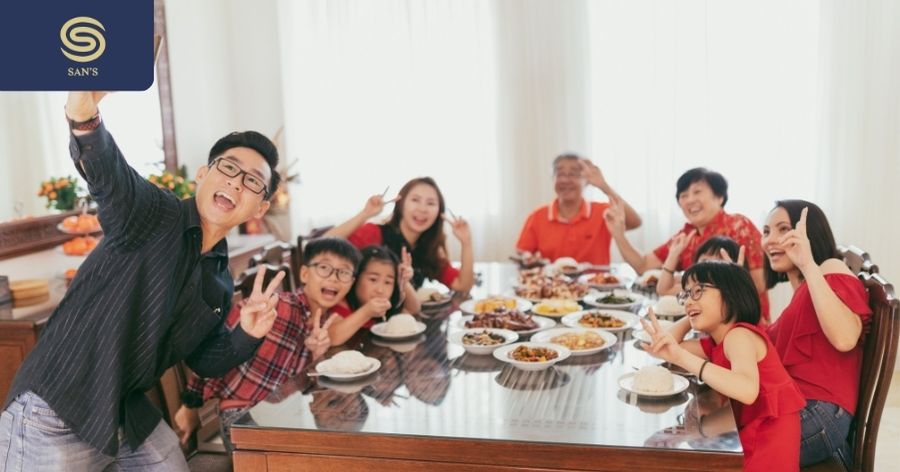
On the evening of Tất niên, families prepare an offering tray to honor their ancestors, a gesture that symbolizes respect and remembrance. The most sacred time of the Lunar New Year celebration, however, arrives between midnight and the early hours of the first day of the new year, specifically during the Tý Hour (from 11:00 PM to 1:00 AM). At exactly midnight, known as Chính Tý, the transition from the old year to the new year is celebrated, a moment called Giao Thừa.
To honor this pivotal moment, two offering trays are traditionally prepared. One is placed on the ancestral altar inside the home, while the other is set up outdoors to honor the heavens and the earth. In some communities, where the tiger is considered a revered symbol, the outdoor offering is referred to as Cúng Ông Ba Mươi.
What is New Year’s Eve?
Giao Thừa marks the sacred transition from the old year to the new, a time when families come together to exchange heartfelt wishes for health, happiness, and success. Across Vietnam, the atmosphere is electric as cities and towns celebrate with dazzling firework displays lasting 10 to 15 minutes in open, spacious areas, creating unforgettable moments for all to enjoy.
For Lunar New Year 2025, Giao Thừa will occur at midnight (0:00 AM) on January 29, 2025, aligning with the first day of the lunar calendar. This moment is not only a celebration but also a spiritual ritual. Families perform the Giao Thừa offering to symbolically cast away the misfortunes and negativity of the past year, making way for blessings and prosperity in the year to come.
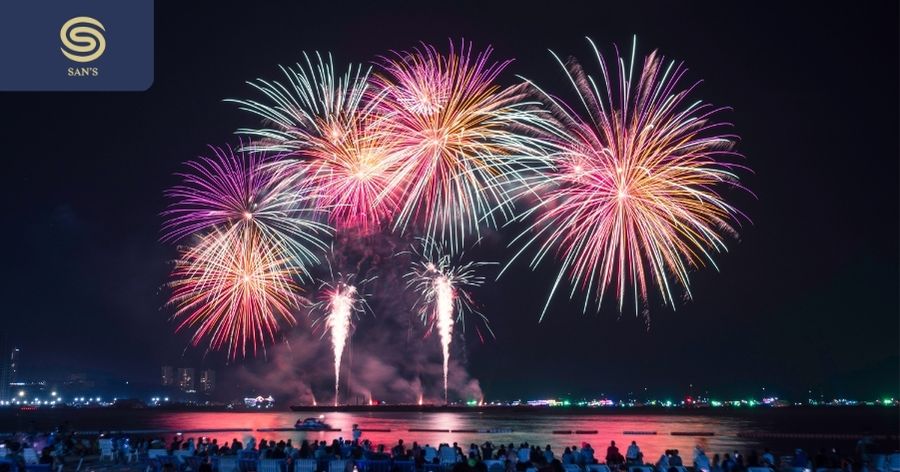
This powerful blend of tradition, joy, and hope makes Giao Thừa one of the most anticipated and meaningful events of the Lunar New Year, bringing people together in unity and anticipation for a brighter future.
>> Read more: Vietnamese New Year is celebrated according to the lunar calendar
How long do people in Vietnam get off during Lunar New Year 2025?
The Lunar New Year, or Tết Nguyên Đán, is the most significant and eagerly awaited holiday in Vietnam, marking the start of a fresh year with joy and celebration. For Lunar New Year 2025, a proposal has been submitted to extend the public holiday from Saturday, January 25, 2025, to Sunday, February 2, 2025. This would provide a nine-day break, offering ample time for families to reunite, enjoy festivities, and honor long-standing traditions.
By comparison, the Lunar New Year holiday in 2024 lasted for seven days, from February 8 to February 14. If approved by the Prime Minister, the 2025 Tết holiday will reflect the importance of this cultural milestone, giving everyone a well-deserved opportunity to welcome the new year with loved ones and meaningful traditions.
Tet customs in Vietnam
During Tet, traditional Vietnamese customs are fully promoted. So what are those special customs?
Three days of the Lunar New Year 2025
The first day of the Lunar New Year, known as “Mồng Một Tết”, is the most significant day of the entire Tết celebration. Traditionally, only individuals deemed to bring good fortune are invited for the ceremonial “first visit” to the home. Early in the morning, ancient Vietnamese customs discouraged people from leaving their homes. Instead, families focused on preparing offerings for the New Year, sharing meals, and exchanging blessings within the household. For families with grown children who have moved out, this is the day to visit their fathers as part of the tradition known as “Mồng Một Tết cha”.
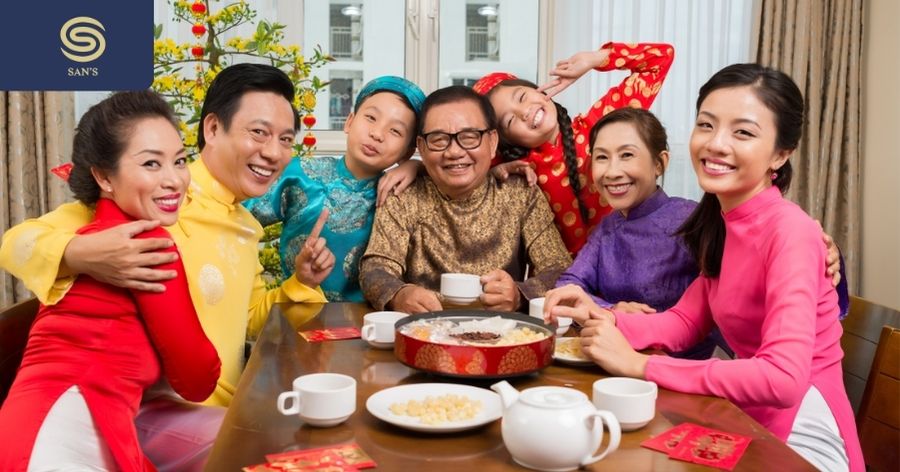
On the second day, families perform morning rituals and offerings at home. This day is dedicated to visiting mothers in accordance with the custom “Mồng Hai Tết mẹ”. For unmarried men preparing for marriage, it is also customary to visit the homes of their future in-laws to offer New Year greetings in a practice called “Đi sêu”.
The third day marks the conclusion of the three-day tradition of offering meals to ancestors. On this day, students often visit their teachers to extend New Year wishes, following the tradition of “Mồng Ba Tết thầy”. These days are also filled with visits to relatives and friends, reconnecting with distant family members, and sharing stories about the past year while expressing hopes for the year ahead.
Xông đất (the first person to enter your house after New Year’s Eve is called “xông đất”)
Xông đất, also known as “đạp đất” or “mở hàng” is a long-standing custom in Vietnam that carries deep cultural and spiritual significance. Many believe that the events of the first day of the Lunar New Year set the tone for the entire year. If everything goes smoothly and brings joy, it is thought that the year ahead will be filled with prosperity and good fortune.
Right after the sacred moment of Giao Thừa, the first person to step into a home and offer New Year greetings is considered to have “xông đất” for the host family. This first visitor is thought to hold great importance, as their personality, demeanor, and fortune are believed to influence the household’s luck throughout the year.
As a result, towards the end of the year, families carefully choose someone from their relatives or neighbors who is cheerful, moral, and successful to visit their home after midnight. The visitor typically stays for only 5 to 10 minutes, offering blessings for the new year and wishing the family smooth, prosperous days ahead.
Xuất hành và hái lộc (Going out and picking lucky branches)
“Xuất hành” (the first outing of the year) is a cherished Vietnamese tradition symbolizing the quest for luck and prosperity for oneself and the family. This significant act is typically performed on an auspicious day and at a favorable hour, as determined by the Hoàng đạo (lucky days and times), with careful consideration of the best directions to encounter blessings from deities of wealth, happiness, or fortune.
Chúc Tết (Tet greetings)
The morning of the first day of Tết, also known as Chính Đán, holds profound significance in Vietnamese culture. On this day, family members gather at the home of the clan leader to perform ancestral rituals and offer New Year wishes to their elders. This practice reflects deep respect for family ties and the importance of honoring one’s roots.
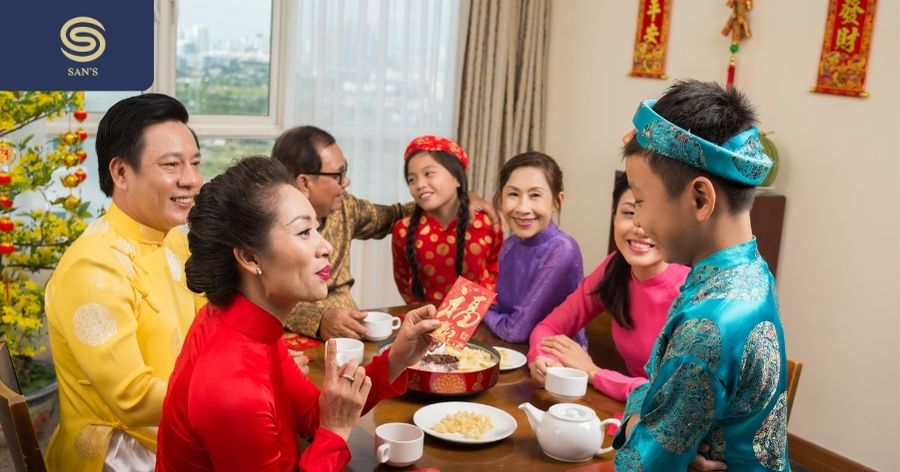
In Vietnamese tradition, Tết marks a universal “birthday” for everyone, as it is believed that each person grows a year older with the arrival of the new year. As such, the first day of Tết is a special occasion for chúc thọ, or offering blessings of longevity, to grandparents and senior family members. In the past, when specific birth dates were often forgotten, Tết was the recognized moment for everyone to add another year to their age.
Visiting customs
Visiting relatives and friends during Tết is a cherished tradition that strengthens family bonds and friendships. Heartfelt New Year wishes for health, prosperity, and good luck are exchanged, while words of encouragement bring hope to those who faced challenges, reflecting the belief in finding blessings even in difficult times.
Neighbors and nearby families are also visited, with well-wishes exchanged to strengthen the sense of community. These visits are a time to set aside past disagreements, forgive one another, and embrace the new year with renewed harmony and happiness.
Additionally, visiting friends, colleagues, and loved ones helps deepen connections and expresses appreciation. These gatherings during Tết highlight the importance of unity, compassion, and joy, making the New Year a time of celebration and renewed relationships.
Mừng tuổi (Send lucky money)
During Tết, adults give children red envelopes, or “hồng bao”, containing lucky money, known as “lì xì”. Along with the money, they offer blessings for good health, rapid growth, and success. Children typically receive lì xì until they graduate from university and begin their careers.
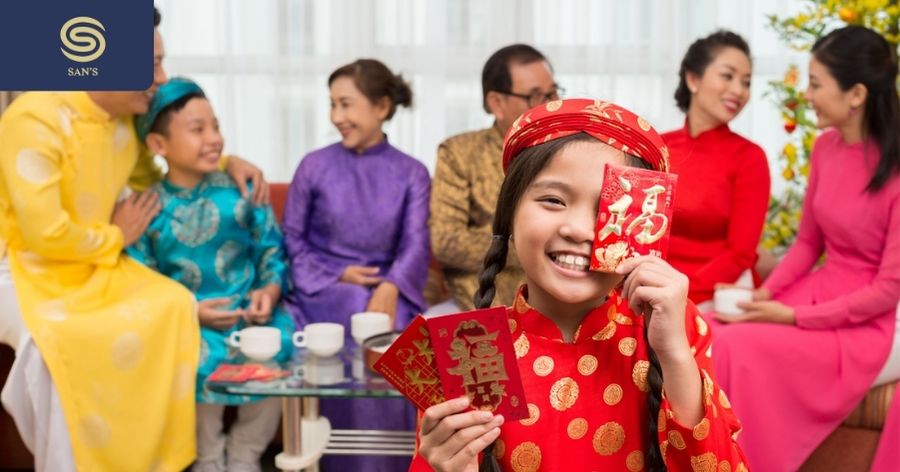
Lucky money is also given to the elderly, accompanied by wishes for longevity, happiness, and joy with their family. Seniors, often aged 60 and above, receive larger sums as a token of respect and gratitude. This tradition symbolizes the sharing of blessings and the deep bonds of love and care between generations during the Lunar New Year.
Hóa vàng (burning prayer paper)
On the 4th day of the Lunar New Year, traditionally known as “Ngày Con Nước,” Vietnamese families hold ceremonies to bid farewell to ancestors who have returned to celebrate Tết with their descendants. As part of this ritual, offerings are made, and prayer paper, or “vàng mã,” is burned to provide the ancestors with symbolic money for the afterlife.
This act is believed to bring blessings and prosperity to future generations. In some regions of the Red River Delta, people also perform folk songs, known as “chèo đò,” to guide their ancestors back to the spiritual world.
Hóa vàng often takes place on the 4th or 5th day of the New Year, with families preparing special meals and burning symbolic items that reflect daily life. These offerings signify a connection between the living and the departed, ensuring that the spirits remain close to their earthly families.
Though this practice has faded in some areas, many families still embrace the tradition as part of their Tết celebrations. Meanwhile, others use these days to continue visiting relatives and exchanging New Year wishes, blending modern customs with ancestral respect.
Unique things during Lunar New Year 2025
Visiting Tet market
Tết markets are vibrant, bustling gatherings held from the 25th to the 30th day of the last lunar month, offering a wide range of goods, especially those for Lunar New Year celebrations. Items like lá dong (dong leaves) for wrapping bánh chưng, glutinous rice for making sticky rice and bánh chưng, roosters, flowers, and fruits for ancestral offerings are among the most popular.
Since most vendors pause their business during Tết, shoppers flock to these markets to stock up on essentials until trade resumes. The high demand makes Tết markets especially lively. An old Vietnamese saying, “Mồng bốn chợ ma, mồng ba chợ người” (the 4th day for ghost markets, the 3rd day for human markets), reflects that most markets resume operations on the 3rd day of the Lunar New Year.
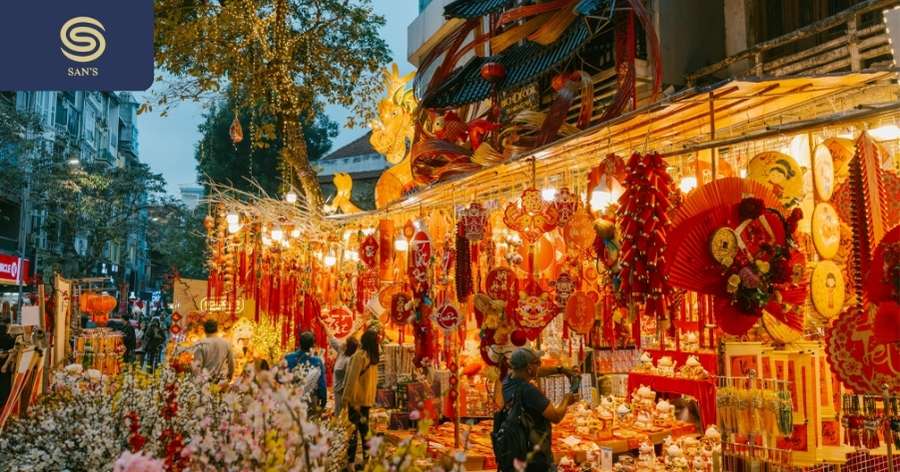
=> See more: Hanoi Vietnam Weather December Travel Guide and Essentials
Tết markets are not just about buying necessities; they also satisfy aesthetic and cultural needs. Shoppers delight in purchasing festive flowers, fruits like watermelons, and fruits with symbolic names such as custard apple, coconut, papaya, and mango, believed to bring luck and prosperity.
Special Tết markets conclude before the midnight of Lunar New Year’s Eve, with many markets staying open all night. Night shopping at Tết markets is a unique and joyful experience. Additionally, flower markets organized before Tết add to the festive atmosphere.
Tet trees and flowers for Tet decoration
Flowers and plants play a significant role in Tết decorations, symbolizing renewal and good fortune. In addition to the iconic peach blossoms in the north and apricot blossoms in the south, homes are adorned with flowers for both worship and decoration. Worship flowers often include marigolds, chrysanthemums, gladiolus, and tuberose.
Decorative flowers feature a wide range of vibrant colors, such as roses, narcissus, orchids, dahlias, violets, and gerberas. Combining these with other blooms like carnations, lilies, and asters creates striking arrangements that symbolize reunion, prosperity, and happiness for the new year.
In Northern Vietnam, red peach branches are commonly placed on altars or used to decorate homes. According to Chinese influence, peach trees are believed to ward off evil spirits, with their vibrant red color symbolizing life force and bringing wishes of good luck and blessings for the spring.
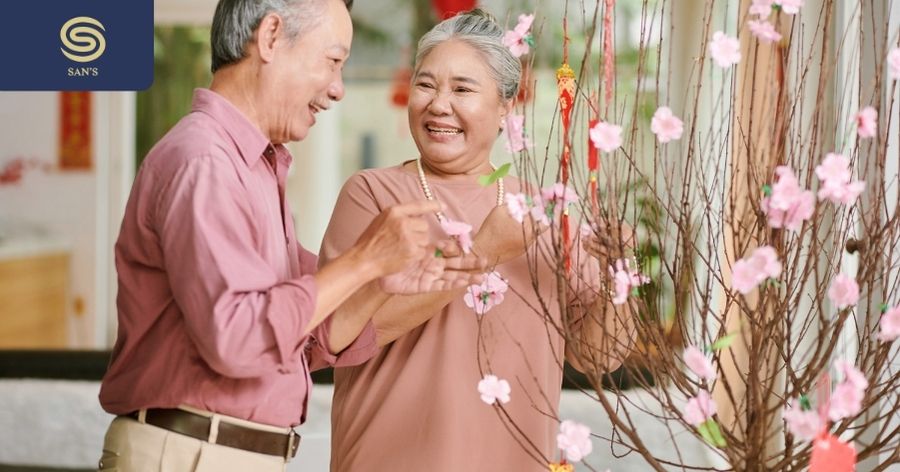
In Central and Southern Vietnam, the tropical climate favors the blooming of yellow apricot blossoms, a staple of Tết decor in these regions. The golden hue represents nobility, success, and prosperity, with a historic association to royalty during the feudal era.
Câu đối
A traditional way to decorate homes and celebrate spring, red couplets have long been a cherished Tết custom. Written in Chinese characters, the couplets are inscribed in black or gold ink on red or peach-colored paper, earning them the name “red couplets”. These couplets are displayed to bring luck and joy to the household.
Mâm ngũ quả
The five-fruit tray is an essential part of Tết, symbolizing the host’s wishes for the new year through the selection, colors, and arrangement of fruits. In the North, common fruits include bananas, pomelos, peaches, persimmons, and mandarins, or combinations such as bananas, chili, pomelos, kumquats, and pears. Northern families value colorful trays without strict rules on fruit selection.
In contrast, Southern families often choose custard apples, figs, coconuts, papayas, and mangoes, representing the wish for “Cầu Sung Vừa Đủ Xài” (praying for sufficient resources). Like the North, Southern families emphasize meaning over rigid rules.
Wrapping “banh chung” (chung cake)
Bánh chưng is a traditional square cake that represents gratitude toward ancestors and the earth. Made from glutinous rice, mung beans, pork, and wrapped in lá dong (dong leaves), the cake is boiled to perfection. It is a quintessential dish for Tết and other significant occasions like the Hùng Kings’ commemoration day.
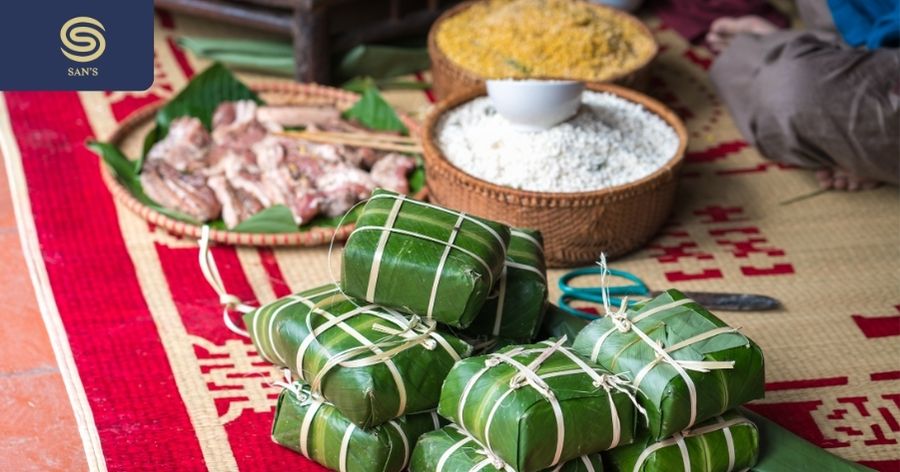
Participate in spring festivals
Tết is also a time for vibrant festivals across Vietnam, each reflecting local cultural traditions. Activities include human chess, boat races, wrestling matches, “đánh còn” (a shuttlecock game), lion and dragon dances, and dove releasing. These events are unique to each region and offer visitors a glimpse into Vietnam’s rich heritage.
In Hanoi, several famous festivals take place after Tết. On the 5th day of the Lunar New Year, the Quang Trung Festival is held at Đống Đa Mound in Quang Trung Ward, Đống Đa District. The 6th day marks the start of the Cổ Loa Festival in Đông Anh District, the Perfume Pagoda Festival in Mỹ Đức District, and the Hai Bà Trưng Temple Festival in Mê Linh District. These festivals are not to be missed if you have the chance to visit.
Here is the “Celebrating Lunar New Year 2025: Traditions, Customs, and Joy in Vietnam”. Wishing you a delightful trip to Vietnam! If you’re visiting Vietnam and the capital, Hanoi, you can book a room at San Hotel at the best prices here!
Follow us on Facebook to get the latest travel updates daily: San Hotel Series



